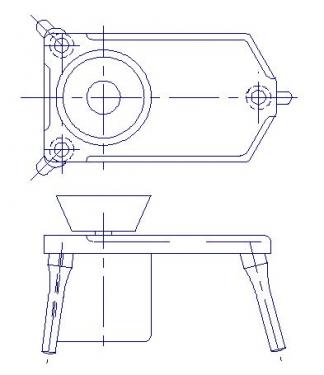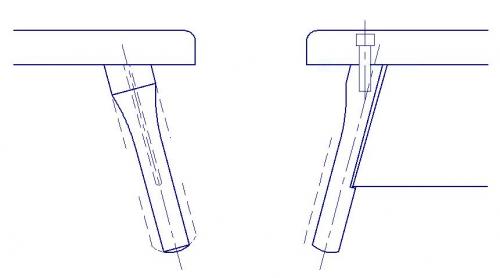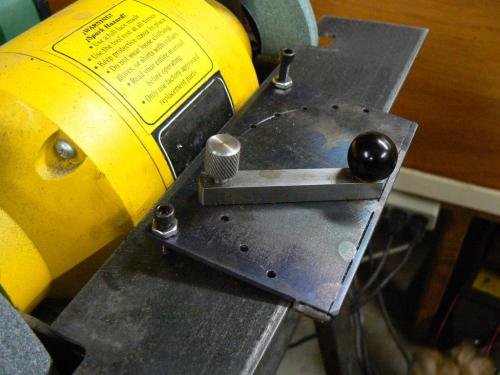I've not been in the shop for several weeks, it's been rainy/cold and my shop is unheated. There has been little progress on my diamond grinder although some needed Delrin material has arrived.
As I have written previously, I’d like for this thing to be sorta’ designed rather than just cobbled away from any material that comes to hand, as is my usual practice. I cannot say that I’ve succeeded at that, ha-ha-ha, but I’ve made an attempt.
This (created in my warm living room) is a layout of the grinder, minus the tool holder.

I fiddled around with various contours for the three legs that support the baseplate of the grinder. The idea of three stubby uncontoured legs seemed unattractive, no reason not to make them look nice, right ?
This sketch also depicts the mounting of legs to grinder table and part of the sheet metal panel that will include a socket for the power cord, enabling switch and a (mostly unnecessary) circuit breaker.

Although preliminary, here’s a working sketch for the base of the tool holder:

I don’t know when I’ll attempt to convert the sketches into parts, it’s likely to be damp and chilly out there for a while !
Considering that, it is annual practice, prior to the rainy season, to protect exposed surfaces of wood-working and sheet metal machinery and any hand tools that are not already protected *. Not much care is required for the metal-working machines due to the near-constant application of cutting oil and lubricants.
(*I use a weird mixture of turpentine, beeswax and furniture oil. I read about this in a “Fine Woodworking” issue about two decades ago. I compounded the mixture from curiosity, but it seems to work well. I believe that the author especially recommended using it on plane knives. I stick my chisels, woodworking drill bits, plane knives - anything sharp - into the stuff before the rainy season.)
Meanwhile on another topic – well actually the one that started this post – I made a slight modification to the sliding tool sharpener that I use for grinding lathe tools I was embarrassed about revealing my crude means of adjusting the height of the slide (using the bulldog clamp).
I drilled/tapped a couple of #6-32 holes in the corners of the slide. This enables angular adjustments for various cutting tool angles. Both of the screws/nuts in the photo are not required for the actual grinding process. Only one adjustment screw is actually used, opposite the side where grinding takes place. (If both screws were installed, the workpiece might be blocked from and unable to reach the grinding wheel.)

One of these days I’ll make a knurled thumbscrew and nut :o) But NOT #7-32 !!!
As I have written previously, I’d like for this thing to be sorta’ designed rather than just cobbled away from any material that comes to hand, as is my usual practice. I cannot say that I’ve succeeded at that, ha-ha-ha, but I’ve made an attempt.
This (created in my warm living room) is a layout of the grinder, minus the tool holder.
I fiddled around with various contours for the three legs that support the baseplate of the grinder. The idea of three stubby uncontoured legs seemed unattractive, no reason not to make them look nice, right ?
This sketch also depicts the mounting of legs to grinder table and part of the sheet metal panel that will include a socket for the power cord, enabling switch and a (mostly unnecessary) circuit breaker.
Although preliminary, here’s a working sketch for the base of the tool holder:
I don’t know when I’ll attempt to convert the sketches into parts, it’s likely to be damp and chilly out there for a while !
Considering that, it is annual practice, prior to the rainy season, to protect exposed surfaces of wood-working and sheet metal machinery and any hand tools that are not already protected *. Not much care is required for the metal-working machines due to the near-constant application of cutting oil and lubricants.
(*I use a weird mixture of turpentine, beeswax and furniture oil. I read about this in a “Fine Woodworking” issue about two decades ago. I compounded the mixture from curiosity, but it seems to work well. I believe that the author especially recommended using it on plane knives. I stick my chisels, woodworking drill bits, plane knives - anything sharp - into the stuff before the rainy season.)
Meanwhile on another topic – well actually the one that started this post – I made a slight modification to the sliding tool sharpener that I use for grinding lathe tools I was embarrassed about revealing my crude means of adjusting the height of the slide (using the bulldog clamp).
One of these days I’ll make a knurled thumbscrew and nut :o) But NOT #7-32 !!!




